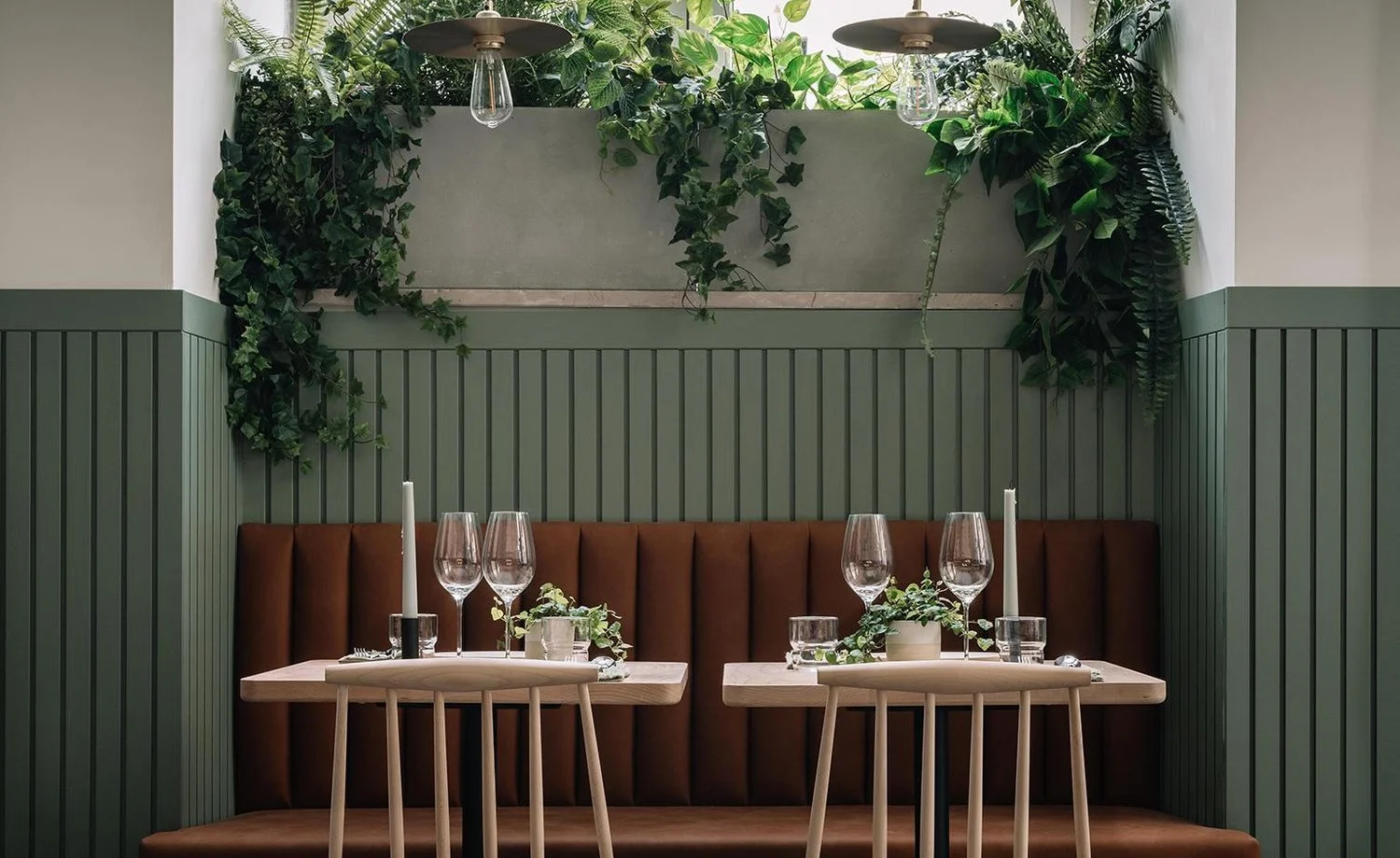Designing Flavour: How Diogo Noronha Studio Blends Food, Art & Emotion in Lisbon
A visionary studio crafting high-end gastronomic experiences
that blend food, aesthetics, and storytelling
—
At the crossroads of gastronomy, design, and storytelling, Diogo Noronha Studio is redefining how we experience food. With a philosophy deeply rooted in seasonality, sustainability, and artistry, the studio transforms each meal into a multisensory narrative, one that seamlessly blends flavours, aesthetics, and meaning.
Founded by chef Diogo Noronha and creative director Carlota Morais Pires, the studio approaches food as more than sustenance; it is a medium for communication, an extension of brand identity, and a stage for artistic expression.
Diogo Noronha Studio
From conceptual dinners to high-end brand activations, each project is designed with a unique narrative in mind, shaped by a moodboard of influences - from fashion and architecture to contemporary art. Set design, lighting, and materials are considered just as carefully as ingredients, ensuring that every element contributes to an overarching vision. The result? A sensory journey that is not only visually stunning but also emotionally resonant.
1. What’s the first thing you think about when designing a new gastronomic experience? Is it the ingredient, the setting or the emotion you want to evoke?
It’s never a linear process for us. Everything starts with a briefing from the client and that defines how we approach each element of the experience. Sometimes it begins with a single ingredient, other times with a specific atmosphere, a design element or even a colour. We let the intention behind the experience guide the narrative — whether it’s emotional, sensorial or purely visual — and then build around that to create something truly immersive and cohesive.
2. How do you turn a moodboard into a fully realised gastronomic experience? Can you walk us through the process?
A moodboard is where the dialogue begins — it helps us translate abstract ideas, emotions and aesthetics into a shared visual language. From there, we start to layer meaning and intention. We explore ingredients that align with the concept, textures that mirror the mood and compositions that feel coherent with the atmosphere we’re trying to evoke.
It’s a very collaborative process between the creative, culinary and production sides. We experiment, refine and prototype — not just the food, but also the table setting, the lighting, the sequence of moments. It’s about creating a narrative that feels seamless and sensorial, where every detail — from the first bite to the final impression — is aligned with the original vision.
3. Do seasonal and ethical sourcing constraints fuel your creativity or make it more challenging?
They absolutely fuel our creativity. Working with seasonal and ethically sourced ingredients gives us a framework — and within that framework we find new possibilities. Constraints often push us to be more inventive, to look deeper and to highlight what nature offers at that specific moment in time. There’s also something beautiful about accepting that not everything is available all year round — it makes each ingredient more precious, more intentional.
4. What’s one unexpected ingredient that you think deserves more attention?
One ingredient we love working with — and that still feels underrated — is seaweed.
It’s incredibly versatile, rich in umami and deeply connected to our coastal identity. Beyond its nutritional value, it brings a sense of place to the plate, evoking the ocean in a very pure, almost poetic way. We’re constantly exploring how to use it in new, unexpected contexts.
5. Do you think the future of gastronomy is moving toward more immersive, multi-sensory experiences? Where do you see this trend going?
Absolutely — we believe the future of gastronomy is deeply rooted in immersive, multi-sensory experiences, but also in a growing awareness of our connection to Nature. We see the future of gastronomy moving closer to performance, design and storytelling — where sound, light, scent and texture all play a part in shaping how food is experienced. On the other side, people are not just looking for spectacle, they’re looking to feel something — to reconnect.
For us, that means designing experiences that reflect the rhythms of the seasons, that honour the ingredients’ natural cycles, and that create a sense of place and time. It’s about engaging all the senses, yes — but also inviting people to slow down, to notice, and to appreciate where things come from and how they’re made. In a way, it’s less about adding layers, and more about creating space for presence and meaning.
6. Many brands use food as part of their marketing, but not all do it authentically. What makes a gastronomic experience truly meaningful rather than just a gimmick?
Food is one of the most powerful forms of communication we have. It connects us instantly — to place, to memory, to emotion. But for a gastronomic experience to be meaningful, it has to come from a place of truth. It’s not about decoration or trends. It’s about intention. Why this ingredient? Why this gesture? Why now?
Authenticity, for me, comes from alignment — between the values of the brand, the essence of the food, and the people it’s meant for. If those three elements are in harmony, the experience becomes unforgettable. If not, it disappears the moment it ends.
7. If you could create a dining experience inspired by music, fashion, or film, what would it be?
I’m constantly inspired by music. It’s something that moves me deeply and influences the way I cook, the way I think, the way I feel. If I were to create a dining experience inspired by music, it wouldn’t be about recreating a specific style or artist — it would be about capturing a mood, an energy.
It would be something intimate and emotional. A space where sound and flavour are connected — where what you hear enhances what you taste. For me, music has always been a way to access memory and emotion. And I think food works the same way. So the idea would be to create a moment where the two come together — not in a theatrical way, but in a way that feels natural.
8. How have your international experiences influenced your creative vision?
Living and working in cities like New York and Barcelona had a huge impact on the way I see the world — and on the way I cook, think and create. I had the chance to work in some of the most respected kitchens internationally, where I learned not only technique, but also discipline, precision, and how to push creative boundaries without losing coherence.
But more than that, those years abroad gave me perspective. They exposed me to different cultures, aesthetics, and ways of living. I absorbed visual references, new ingredients. It was also in New York, and during my travels in India, that I started to explore a deeper relationship with plant-based and plant-forward cuisine. Not just as a trend, but as a philosophy — a way of highlighting the purity, the energy, and the emotional resonance of ingredients that are often treated as background. That changed everything. It taught me to be more attentive, more respectful, and to create from a place of intention and intuition.
Today, I carry those experiences with me. They allow me to move between worlds and bring a certain openness — both in the way I build a dish and in how I design an atmosphere. Traveling changed my craft — but more importantly, it changed my way of being.
9. How does Lisbon’s culture, food scene, or design aesthetic influence your work?
Lisbon is always present in my work — sometimes in obvious ways, sometimes in more abstract ones. It’s the city where I was born and where I keep returning to. The food scene here is layered — you have tradition, nostalgia, but also a quiet kind of innovation. Lisbon’s subtlety influences me a lot. I’m drawn to simplicity with depth, and Lisbon has that in the way people cook, eat and live.
There’s also a certain raw beauty in the city — the light, the cracked tiles, the sound of the street. All of that feeds my creative process. Lisbon teaches me to slow down, to pay attention and to create from a place that’s real, not performative.
10. What’s the most rewarding part of working together, and how do your strengths complement each other?
The most rewarding part of working together is the way we build from a shared sensitivity. Carlota has a very intuitive understanding of what I’m trying to express — even before it fully takes shape. There’s an emotional and creative alignment that makes the process feel fluid, honest, and deeply collaborative.
Through The Communication Studio, she brings a layered perspective that enriches the work — not just in how it's communicated, but in how it’s imagined from the beginning. We think through the experience together — from the initial idea to how people will feel in the space, what they’ll take with them, what will stay. There’s a constant dialogue between us, we are both very passionate about our work and this project.
11. If you had to describe your project in three words, what would they be?
Curatorial. Immersive. Environmentalist.
Everything we create is carefully curated — from the ingredients to the atmosphere, from the materials to the mood. The experiences are immersive, engaging all the senses and inviting people to slow down and feel fully present. And there’s always an environmental consciousness behind each choice — a respect for nature, for seasonality, for the balance between beauty and responsibility.
See here Diogo and Carlota’s answers to our Rapid Fire interview.
Discover Lisbon through the eyes of Carlota and Diogo’s eyes as they share their favourite spots in the city.
If you enjoyed this article, you should check out our article An exclusive interview with Marie Pidancet, founder of Louise Misha

































